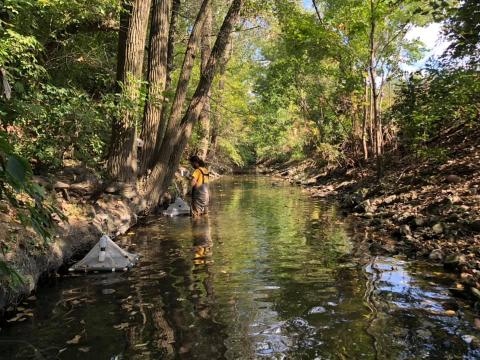Fish, frogs and… pharmaceuticals? How researchers are addressing Ohio’s medicated streams

Listen to this Episode
Algal blooms and forever chemicals often dominate the conversation around water quality in Ohio. But, researchers across the state say there’s another, lesser known threat to Ohio streams: medications.
Kevin McCluney, a researcher at Bowling Green State University, is collecting samples from wastewater and streams in nine northwest Ohio cities. He’s found residue from a wide range of pharmaceuticals – from over-the-counter medications, like antidepressants, to illicit drugs, like fentanyl, to common stimulants, like caffeine.
“It's unlikely that [people] are going to be directly exposed to these chemicals,” McCluney said. “But the chemicals there are changing the food web and changing the ecosystem.”
The McCluney Lab, a group of academics and graduate research students, are diving deeper into how these pharmaceuticals are altering the environment – a topic that, according to McCluney, is severely understudied.
Worries over wildlife
McCluney said research across the world shows that these drugs aren’t good for streams. Research out of Australia has documented high concentrations of pharmaceuticals in wildlife on the edges of streams. Fish, in particular, can take in harmful levels of antidepressants.
“Then, there is the potential for humans to be exposed through fishing, for instance, or other kinds of consumption of wildlife,” he said.
But, little is known about how these pharmaceuticals interact with one another in the water. That’s what McCluney aims to study.
“It's not just one chemical by itself,” he said. “Organisms in streams are exposed to a mixture of a variety of chemicals, and we have a relatively poor understanding of how those mixtures influence the organisms living in those streams.”

McCluney said his team’s research has also confirmed that the medications are disruptive to streams’ food chains. He said they’ve found large amounts of caffeine residue can reduce the number of adult aquatic insects, which many species rely on for food.
“So when you expose streams to these suites of chemicals, you might see a decrease in birds, bats and other lifeforms that depend on [insects],” McCluney said.
A potential tool
Down the line, McCluney hopes his research can lead to a targeted effort to reduce these chemicals in streams. But, McCluney said his research is about more than just water quality. He said the data can also be used to help towns address the opioid crisis.
Local public health officials could use wastewater sampling as a means of identifying illicit drug hot spots and make informed decisions on where to send resources.
“For instance, if you see a spike in fentanyl in a particular location, you might send additional doses of Narcan in that area to help treat that,” he said.
It’s a tool that’s been utilized by public health officials during the coronavirus outbreak to track the spread of COVID-19. Now, McCluney said more Ohio communities should use this strategy for overdose prevention.
He said comparing different cities’ samples might also give insight into gaps in care.
“Why are some locations using those substances more commonly than in other locations?,” McCluney said. “And that might reveal something interesting about health care availability in that area, for instance.”
9(MDYwODMwNTczMDE2ODk5NTExNDAyNzM5Ng000))
- Home
- Schedules
- TV
- TV
- Local TV Programs
- Business | Life 360 with Kristi K.
- Toledo Stories
- To The Point with Doni Miller
- Listening with Keith Burris
- Ideas & Insights
- WGTE Presents
- BL360: Northwest Ohio Innovation Consortium
- Magic of the Old West End
- Freedom Means Never Surrender
- I&I: The Random Factor
- FF: National Cherry Festival
- TTP: Moms Demand Action For Gun Sense in America
- Watch Live
- Radio
- Education
- Community
- Support
- About
- Donate
- Watch Live


